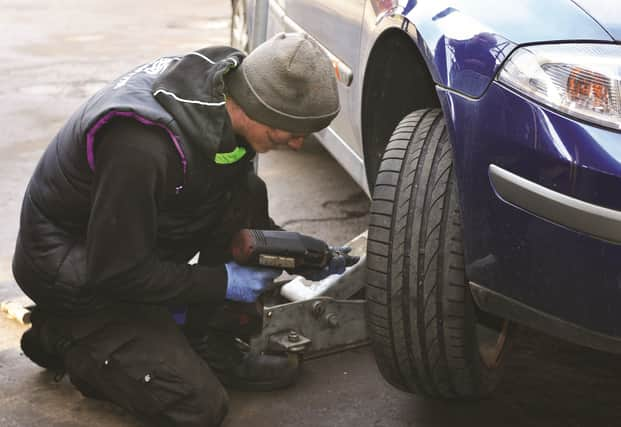MOTORING: Maintaining top tyre safety


If your brakes are faulty you risk being unable to stop in an emergency; if your tyres are faulty any attempt at stopping suddenly can be disastrous and if a badly-maintained tyre blows at speed there can be terrible repercussions.
Maintaining top tyre safety should be at the forefront of every driver’s thinking.
Advertisement
Hide AdAdvertisement
Hide AdFailure to do so could lead to big fines and tragic accidents.
Surveys by TyreSafe have shown that a staggering one in five drivers never check their tyres, and the number of illegal tyres on Britain’s roads could be around a frightening 10 million.
Drivers with illegal tyres can now get a £2,500 fine and three penalty points per tyre.
Why is tyre pressure important? Under-inflated tyres affect handling and grip, potentially causing irregular or unpredictable vehicle behaviour. They are also more likely to suffer from a dangerous sudden rapid deflation, especially on motorway journeys.
Advertisement
Hide AdAdvertisement
Hide AdBy keeping your tyres at their optimum pressure, your running costs are also reduced. Under-inflated tyres require a bigger force to make them turn, so your car uses more fuel. Additionally, tyres which are not set to their correct pressure wear out more quickly. So, to benefit from lower fuel bills, longer tyre life, increased safety and reduced CO2 emissions, make sure you check your tyre pressures at least once a month and before a long journey.
Tyre treads are designed to give good grip on wet roads but this decreases as a tyre’s tread pattern wears down or as the depth of water increases. Drivers should take this into consideration and reduce their speed accordingly in wet conditions.
The legal minimum tread depth for cars in the UK is 1.6 mm throughout a continuous band comprising the central three-quarters of breadth of the tread and around its entire outer circumference. In wet weather tyre tread grooves help to remove water from the contact patch between your tyres and the road surface meaning your car can brake, steer and accelerate properly. Without adequate tread depth your tyres may not be able to perform properly in wet conditions, reducing your safety on the road. It is therefore advisable to consider replacing your tyres well before they reach the legal minimum.
Tyres should ideally be checked every week — at a minimum every month — and before heading off on long journeys.
Advertisement
Hide AdAdvertisement
Hide AdMotorists need to look at pressure, tread, cuts and any bulges. A tyre can be underinflated without looking flat.
Tread depth can be easily checked with a 20p piece. Place the coin in the grooves of the tread. If you can see some of the outer edge of the 20p, then your tyres may be illegal.
This test should be performed on all parts of the tread, on all four tyres.
A set of tyres well maintained and used solely for motorway driving can return a much higher mileage by comparison to those which are poorly maintained and driven badly in a city centre.
Advertisement
Hide AdAdvertisement
Hide AdMotorists should consider using summer tyres during the months April to October and then from November to March cold weather tyres are recommended. Indeed there is a legal requirement in some European countries for drivers to keep two sets of tyres for these periods.
While it is better to fit four new tyres at the same time, this may not always be realistically possible. Fitting two tyres at a time, and as a pair, to enable the best handling and grip on each axle is therefore the next best thing.
So think about your tyres and keep yourself, and others on the road, as safe as possible.